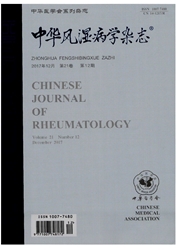

 中文摘要:
中文摘要:
目的 检测多发性肌炎肢肌炎患者血清抗氨酰tRNA合成酶(ARS)抗体水平,并与抗Jo-1抗体相比较,探讨其在特发性炎性肌病伴间质性肺疾病(ILD)中的意义。方法采用酶联免疫吸附试验(ELISA)法测定109例多发性肌炎,皮肌炎患者,20例系统性红斑狼疮(SLE)患者,20例类风湿关节炎(RA)患者以及30名健康对照组血清中抗ARS抗体水平及阳性率。使用t检验、Mann,WittneyU检验、r检验及Fisher精确检验分析ARS阳性患者的临床特点。使用McNemar检验比较抗ARS抗体和抗Jo-1抗体对诊断多发性肌炎/皮肌炎合并ILD的敏感性及特异性。结果血清抗ARS抗体的阳性率在合并ILD的多发性肌炎,皮肌炎组、未合并ILD的多发性肌炎,皮肌炎组、SLE组、RA组及健康对照组分别是37.9%、7.8%、10%、0和0。合并ILD的多发性肌炎/皮肌炎组血清抗ARS抗体阳性率较未合并ILD的多发性肌炎,皮肌炎组、SLE组、RA组和健康对照组均显著升高(X2=-13.5,5.45,10.57,15.17;P〈0.01)。抗ARS抗体诊断多发性肌炎,皮肌炎合并ILD的敏感性显著高于抗Jo-1抗体(37.9%比17.2%,P〈0.01),而两者特异性差异无统计学意义(P>0.05)。抗ARS抗体阳性患者发热、ILD发生率较抗ARS抗体阴性患者显著升高(X2=12.55,13.53;均P〈0.01),而披肩征及向阳疹的发生率则低于ARS阴性组(X2=5.7,5.8;P均〈0.05)。抗ARS抗体阳性组同抗Jo-1抗体阳性组间临床特点差异无统计学意义(P均〉0.05)。随访发现多发性肌炎,皮肌炎合并ILD死亡患者血清抗ARS抗体均为阴性。结论相较抗Jo-1抗体而言,血清抗ARS抗体检测对多发性肌炎,皮肌炎伴ILD的诊断敏感性更高,有利于早期诊断,值得临床推广应用。
 英文摘要:
英文摘要:
Objective To determine the serum level of anti-aminoacyl-tRNA synthetase (ARS) antibody in patients with polymyositis (PM) and dermatomyositis (DM) and to investigate the value of anti-ARS antibody for diagnosing interstitial lung diseases (ILD) in patients with PM/DM compared with anti-Jo-1 antibody. Methods Serum anti-ARS antibody concentrations were measured by ELISA in 109 adult PM/DM patients, 20 patients with SLE, 20 patients with RA and 50 healthy controls. T test, Mann-Whitney U test, chi-square test or Fisher exact test were used to compare the sensitivity and specificity for diagnosing ILD in PM/DM patients between anti-ARS antibody and anti-Jo-1 antibody. Moreover, McNemar test was employed to analyze the correlation between the clinical features and anti-MDA5 antibody in PM/DM patients. Results The serum positive rate of anti-ARS antibody was 37.9%, 7.8%, 10%, 0 and 0 in PM/DM patients with ILl) and without ILD, patients with SLE and RA and healthy controls, respectively. Serum anti-ARS antibody levels and positive rate in the PM/DM patients with ILD were significantly higher when compared with PM/DM patients without ILD, patients with SLE and RA andhealthy controls (X2=13.5, 5.45, 10.57, 15.17; P〈0.01) Anti-ARS antibody presented a significantly higher compared to anti-Jo-1 antibody (P〈0.01). The rate sensitivity for diagnosing ILD in patients with PM/DM of fever and ILD were lsignificantly higher in anti-ARS positive group than anti-ARS negative group (X2=12.55, 13.53; P〈0.05), while heliotrope rash and "shawl sign" occurred more often in anti-ARS negative group (X2=5.7, 5.8; P〈0.05). Additionally, follow-up study showed that the serum anti-ARS antibody were all negative in nine patients who died of PM/DM with ILD (P〈 0.05). Conelusion Serum anti-ARS antibody is a stronger predietor for early diagnosis of PM/DM with ILD compared to anti-Jo-1 antibody. The detection of anti-ARS antibody can be widely applied to clinical practice.
 同期刊论文项目
同期刊论文项目
 同项目期刊论文
同项目期刊论文
 Anti-MDA5 antibody is associated with A/SIP and decreased T cells in peripheral blood and predicts p
Anti-MDA5 antibody is associated with A/SIP and decreased T cells in peripheral blood and predicts p 期刊信息
期刊信息
